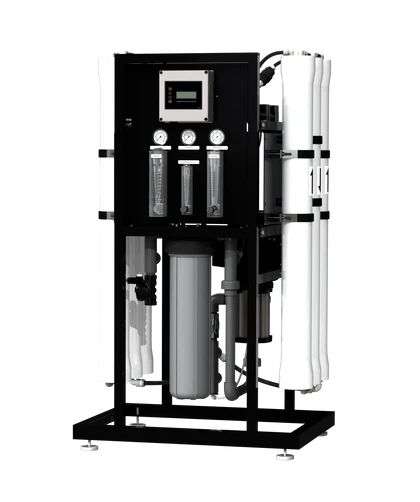Key Components of Commercial Reverse Osmosis Systems
Commercial Reverse osmosis systems used in commercial settings consist of several key components that work together to purify water. The first crucial element is the pre-filtration system, which includes sediment filters to remove large particles and carbon filters to eliminate chlorine and other impurities. These pre-filters help protect the RO membrane from clogging and extend its lifespan.
The heart of the RO system is the semi-permeable membrane, which allows water molecules to pass through while blocking contaminants like dissolved minerals, heavy metals, and bacteria. Pressure is applied to the water to push it through the membrane, separating clean water from concentrated wastewater. The purified water is collected in a storage tank, while the wastewater is flushed away. Various sensors, valves, and controls are also important components that regulate the flow, pressure, and quality of the water produced by the RO system. These components ensure efficient operation and optimal performance of the system.
Understanding the Functionality of Reverse Osmosis Systems
Reverse osmosis systems are highly effective water purification systems commonly used in commercial settings. These systems work by using a semi-permeable membrane to remove impurities and contaminants from water, producing clean and safe drinking water. When water is pushed through the membrane under pressure, the membrane allows only pure water molecules to pass through, while blocking other molecules such as salts, minerals, and contaminants.
The process of reverse osmosis is based on the principle of osmosis, where water naturally moves from an area of lower concentration of solutes to an area of higher concentration. In reverse osmosis, this process is reversed by applying external pressure to overcome the osmotic pressure, forcing water molecules to move from a higher solute concentration to a lower one through the membrane. This results in purified water on one side of the membrane and concentrated waste on the other side, making reverse osmosis an efficient method for water filtration in commercial applications.
Benefits of Using High-Flow RO Systems in Commercial Settings
High-flow reverse osmosis (RO) systems offer substantial benefits for commercial settings due to their increased water production capacity. With higher flow rates, these systems can efficiently meet the demands of businesses requiring large volumes of purified water daily. This enhanced capacity not only ensures a reliable supply of clean water for various applications but also reduces the downtime often associated with refilling or waiting for water production in standard RO systems.
The use of high-flow RO systems in commercial settings promotes cost savings by improving overall efficiency. By producing water more quickly and consistently, businesses can optimize their operations and reduce energy consumption. The increased productivity of high-flow systems allows for greater output with less wastage, contributing to long-term savings on utility bills and maintenance costs.
Factors to Consider When Choosing a Commercial RO System
When choosing a commercial reverse osmosis (RO) system, it is crucial to consider the system’s capacity and flow rate. The capacity of the RO system should align with the water demand of your establishment to ensure that it can meet the required supply. The flow rate of the system should be adequate to provide a continuous and steady flow of purified water without causing any disruptions in your operations.
Another important factor to consider is the quality of the water produced by the RO system. Ensure that the system is equipped with high-quality membranes that can effectively remove contaminants and impurities from the water source. Pay attention to the system’s efficiency and energy consumption to choose a model that not only meets your water purification needs but also operates cost-effectively in the long run.
Maintenance Tips for High-Flow RO Systems
Regular maintenance is essential for ensuring the optimal performance of high-flow RO systems in commercial settings. One important aspect of maintenance is replacing the pre-filters and post-filters as recommended by the manufacturer. These filters help protect the delicate RO membranes from particles and contaminants, prolonging their lifespan and maintaining the system’s efficiency.
In addition to filter replacements, it is critical to monitor the system’s pressure levels regularly. High-pressure levels could indicate a potential issue with the system that needs to be addressed promptly. Furthermore, conducting routine inspections of the system for any leaks, unusual noises, or fluctuations in water quality can help prevent larger problems and maintain the overall functionality of the high-flow RO system.
Comparing High-Flow RO Systems to Standard RO Systems
High-flow reverse osmosis (RO) systems are designed to deliver a higher volume of purified water compared to standard RO systems. This makes them particularly suitable for commercial settings where there is a greater demand for clean water. The increased flow rate of high-flow RO systems allows for more efficient water production, making them a cost-effective option for businesses needing a reliable source of purified water.
In contrast, standard RO systems typically have a lower flow rate, which may not be sufficient to meet the demands of larger commercial operations. While standard RO systems are adequate for smaller-scale applications, they may struggle to keep up with the water needs of businesses requiring a higher volume of purified water on a consistent basis. By comparison, high-flow RO systems offer a practical solution for meeting the substantial water requirements of commercial establishments, ensuring a steady supply of clean water without compromising on quality or efficiency.
